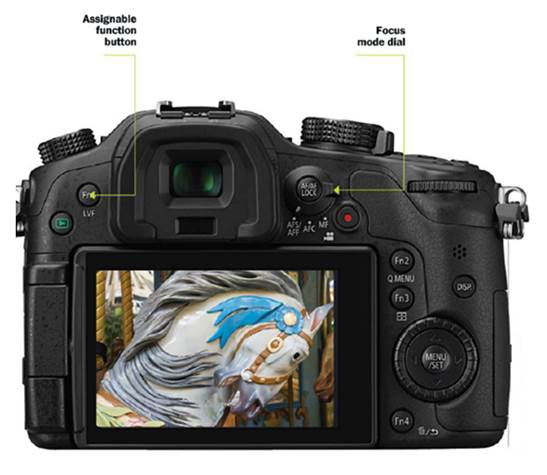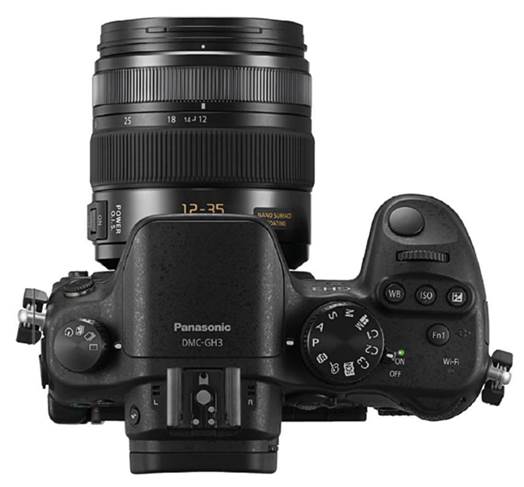In the Field
We’ve been fans of Panasonic’s DSLR-style
ILCs since their inception, and the GH3 is its most impressive body yet. The
level of customization – and integration of hard buttons and touch screen capability
– is unrivaled in the camera world. Even if you disdain touch controls to the
point of never using them, you’ll still be able to achieve a level of control
that will match what you can expect in a DSLR. You can make extremely quick
work of changing a focusing point, switching ISO, and capturing a shot in just
a few moments.
If you’re looking for wonderful
stills and video capture, the GH3 may be for you.
Our biggest gripe? Panasonic eliminated the
click toggle from the command wheel at the top right of the camera back. On the
GH2, it provided a quick way to move between setting aperture (or shutter
speed) and exposure compensation. Now you’ll have to press a button, move your
finger to the front command wheel, and press the button again when you’re done.
Autofocus proved quite fast, among the
speediest we’ve seen in an ILC. Tracking performed well on the subjects we
shot, such as cyclists and cars moving through New York City streets.

Through
the default setting for the magnifying manual-focus assist activates when you
turn the focus ring on a coupled Micro Four Thirds, lens we set it to be
activated by the Fn3 button.
Video from the GH3 was about as good as you
can get in a non-dedicated video camera at this price. If you opt for one of
the high-bit-rate options, be forewarned that you’ll fill memory cards quite
quickly. Persnickety videographers looking to use the GH3 in place of a much
more expensive video camera will likely begrudge this camera the minor moiré or
other artifacts that occasionally show up. But for non-pro shooters, or serious
shooters on a budget, the video form the GH3 should more than suffice.
If you’re looking for the best video
quality you can get out of it, the GH3 does offer uncompressed 8-bit 4:2:0
color-space video through the camera’s HDMI jack. There are built-in stereo
mics, and you can also add an external stereo mic through a mini-jack input.
For more advanced shooters, the GH3 includes support for time-code recording.
So, if you plan to use multiple cameras, syncing them up after the fact can be
simplified somewhat.
Serious burst shooters will like that the
GH3 can shoot at 6 fps with continuous metering and autofocusing. If you can
manage with metering and focus on the first frame only, you can capture up to
20 fps. RAW shooters will have to accept a mere 18 frames when shooting in
bursts, but the number of JPEGs is limited only by the capacity of the memory
card.
Speaking of memory cards, the camera has
only one slot. One the plus side, this has a dedicated hatch, which is
something you can’t always take for granted in the ILC world. If Panasonic
really wants to entice pro photographers to its cameras, it should add a second
slot on the next GH camera, especially given the level of video capture this
series has achieved.
Through the default setting for the
magnifying manual-focus assist activates when you turn the focus ring on a
coupled Micro Four Thirds, lens we set it to be activated by the Fn3 button.
The Wi-Fi functions in the GH3 worked well
when transferring images to a smartphone. We installed the Lumix Link app on a
Samsung Galaxy S3, and had the devices paired and an image on the phone all
within 10 minutes. You can also use the app as a remote to shoot stills or
video.

The
Wi-Fi functions in the GH3 worked well when transferring images to a smartphone
Strangely, though, you can start, but stop,
video. To stop video recording after it has been started with the app, you must
press the video-recording button on the camera. Hopefully this will be fixed
soon with a firmware update, app update, or both.
The Bottom Line
If you’re looking for the Micro Four Thirds
body with the best possible video and wonderful still capture, the GH3 is the
camera for you. Its obvious competition, Olympus’s OM-D, doesn’t offer the same
level of video capture. Even without this advantage, we’d still be inclined to
opt for the GH3 simply because you’d have to add the OM-D’s $250 optional grip
to get the solid handhold ability that you get with the GH3’s built-in grip.
But the OM-D’s retro style has won the hearts of many, many shooters. And while
we like to champion practicality over style, in this case it may be too close
to call.

If
you’re looking for wonderful stills and video capture, the GH3 may be for you
Panasonic Lumix GH3
·
16MP Four Thirds-sized
·
LiveMOS sensor
·
1920x1080p60 video capture
·
OLED EVF
·
6-fps burst shooting
·
$1,298 street, body only
Panasonic Lumix DMC-GH3
·
What’s hot?
·
Rugged body, Excellent image quality
·
What’s not?
·
Large body size rivals DSLRs.
·
Who it’s for
·
Shooters who value video as much as stills and
want a tough Micro Four Thirds body
Test results
·
Image quality: ISO 125-400 (Excellent)
·
Resolution: ISO 125 (2530: Excellent)
·
Color accuracy (Excellent 6.5)
·
Noise: At ISO
·
Extremely low 1.0: 100
·
Very low 1.1: 200
·
Very low 1.5: 400
·
Moderately low 2.2: 800
·
Unacceptable 3.8: 1600
·
Unacceptable 6.5: 3200
·
Unacceptable 9.6: 6400
·
Unacceptable 12.7: 12800
·
Unacceptable 17.9: 25600
·
Highlight/shadow detail: very high
·
Contrast: very high
|
Specifications
·
Imaging: 16MP effective, Four Thirds-sized
LiveMOS sensor captures images at 4912x 3264 pixels with 12 bits/color in RAW
mode
·
Storage: SD, SDHC, SDXC slot stores JPEG, RW2
RAW, RAW + JPEG, and MPO (with optional 3D lens) files
·
Burst rate: Full-sized JPEGs (Fine mode), up
to memory card capacity at 6fps; RAW (12-bit), up to 18 shots at 6fps
·
AF system: TTL contrast detection with 23
focus areas; single-shot and continuous AF with face detection and subject
tracking
·
Shutter speeds: 1/4000 to 60 sec, plus B
(1/3-EV increments); shutter life not rated.
·
Metering: TTL metering with 144-zone
Multi-pattern (evaluative), center weighted, spot (size of spot not
specified). EV 0-18 (ISO 100)
·
ISO range: Standard, ISO 200-12,800 (in 1/3-EV
increments); Expanded, ISO 125-25,600
·
Video: Records at 1920x1080p at up to 60 fps
in AVCHD v. 2.0 (28Mbps); at 1920x1080p at 30 fps in ALL-I (72Mbps) or IPB
(50Mbps) MOV format; built-in stereo microphone; stereo mini-jack mic input.
Maximum clip length 120 min, or 29 min. 59 sec. for units purchased in Europe
·
Flash: Built-in pop-up; GN 40 (feet); covers
14mm (28mm equiv.) field of view; flash sync to 1/160 sec
·
Viewfinder: Fixed eye-level OLED with
1,744,000-dot resolution
·
Monitor: 3-inch articulated OLED touchscreen
with 614,000-dot resolution; 7-step brightness adjustment
·
Output: USB 2.0, mini HDMI video, composite
video, mini-jack stereo headphone, and Wi-Fi
·
Battery: Rechargeable DMW-BLF19PP Li-ion, CIPA
rating 540 shots with Panasonic 12-35mm f/2.8 lens
·
Size/weight: 5.2x3.7x3.2 in., 1.2lb with a
card and battery
·
Street price: $1,298, body only
·
Info: www.panasonic.com
|